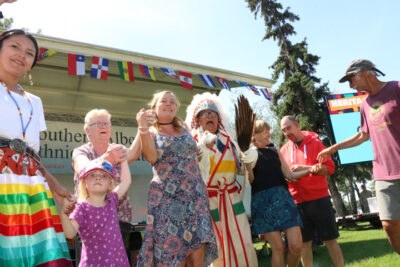Where ya from?
By Lethbridge Herald on August 5, 2025.

Joe Manio
Lethbridge Herald
Local Journalism Initiative Reporter
Hundreds of people gathered at Henderson lake Monday to take part in the Southern Alberta Ethnic Association’s (SAEA) annual signature Heritage Day event.
Alberta Heritage Day, celebrated on the first Monday of August, aims to recognize and celebrate the province’s diverse cultural heritage and the contributions of its people.
“This is the 50th anniversary celebration of Heritage Day in Lethbridge,” said SAEA President Priti Maheshwari. “The first two years were hosted by a group of people. They started hosting it in 1975, and the same group of people founded the Southern Alberta Ethnic Association in 1977.”
While not a statutory holiday, many residents showed up to take part in the day’s cultural performances, family activities and of course the food.
“Festivals like Heritage Day are the perfect platform for people from different backgrounds to come together, celebrate who they are and learn from each other,” said Maheshwari. “This celebration of diversity inclusiveness truly makes Canada a great nation,” she says.
The festivities kicked off with a traditional Chinese lion dance by the Hung Moon Athletic Club, followed by a dance performance by the Blackfoot Canadian Cultural Society.
At the end of their performance, members of the audience were invited to join the performers in a Round Dance (also called a “friendship dance).” Lethbridge resident Meagan Van Den Biggelaar was one of those who joined in.
“It was wonderful to be a part of our community, and honour our friends on their native territory,” said Van Den Biggelaar, who was there with her children. “I love these kinds of festivals, and to bring my children and teach them about our heritage.”
There were other Heritage Day activities in the city, including at Fort Whoop-Up, which offered free admission all day for the occasion.
Numerous visitors, many with family and friends, visited throughout the day.
Fort Whoop-Up offers a variety of historical and cultural attractions including replica buildings like trade rooms, a blacksmith shop, and living quarters, and learning about Blackfoot culture and history through exhibits there.
“Fort Whoop Up has a layered history…you have the Blackfoot component, the early rope trade and the whiskey trade,” said co-ordinator Connor Kenney. “Then you have the fort’s life as a historic site, which started in 1967.”
Fort Whoop-Up was designated a national historic site of Canada in 1963. It is designated because: lawless conditions at Fort Whoop-Up, the earliest and most notorious of the “whisky forts,” hastened the formation of the North-West Mounted Police in 1873 to assure the maintenance of law and order in western Canada.
According to the 2021 census data, the fastest-growing ethnic groups in Lethbridge, as a percentage of the population, were Black, South Asian, and Filipino.
Early ethnic groups contributing to Lethbridge’s heritage include the Blackfoot Confederacy, European settlers (particularly those of British, German, Scottish, and Irish descent), and Chinese immigrants who worked in the sugar beet fields. The Métis Nation of Alberta also has a strong presence in the area according to the City of Lethbridge.
In addition to the prominent groups mentioned above, other European ethnicities like Dutch, Scandinavian, and Ukrainian settlers also contributed to the city’s diverse heritage.
The development of coal mines and the arrival of the railway significantly shaped Lethbridge’s early growth and attracted diverse populations.
19-18


